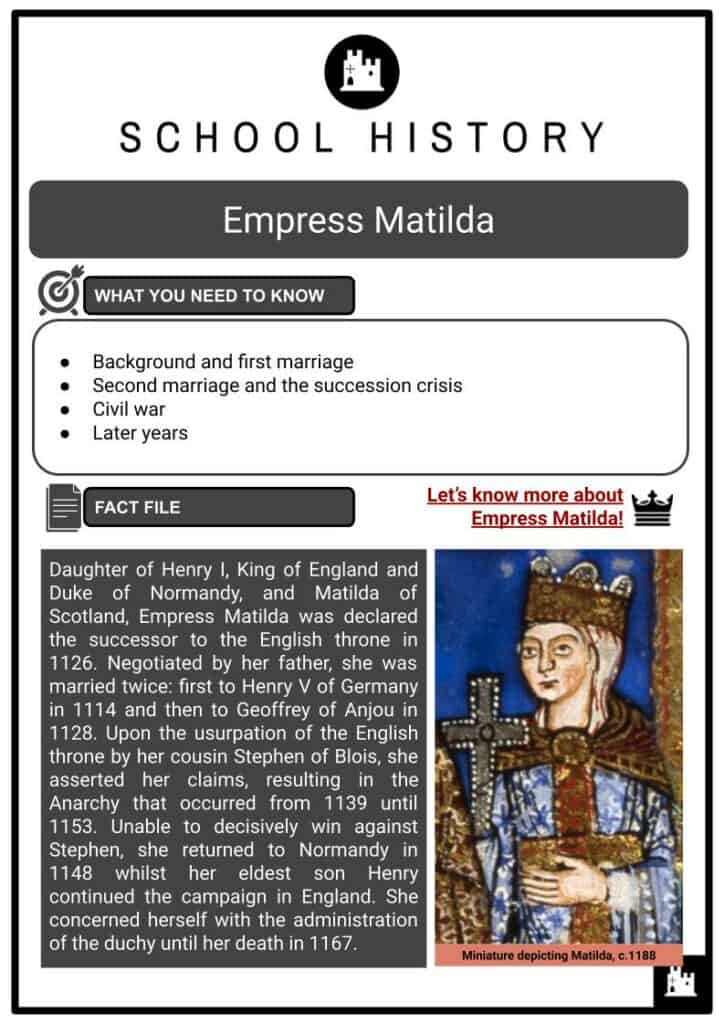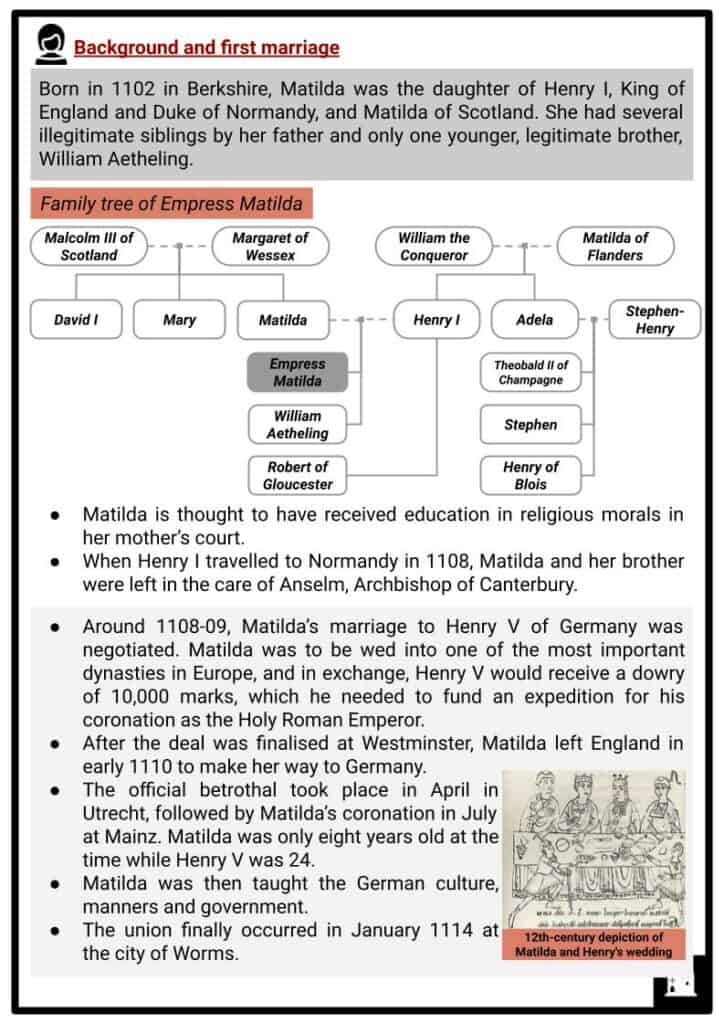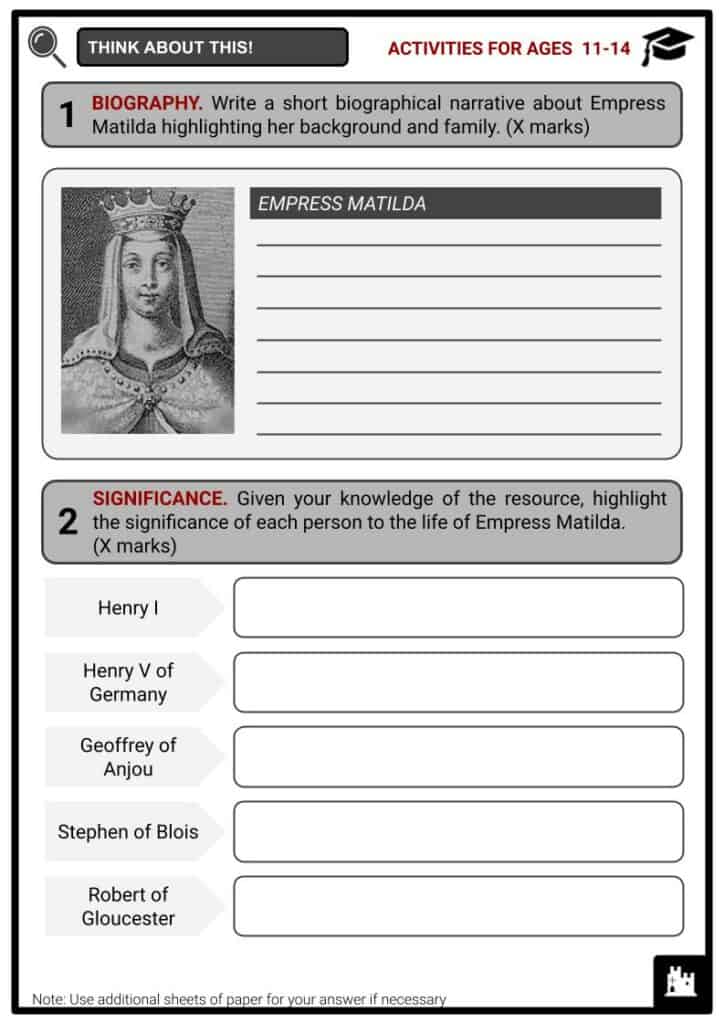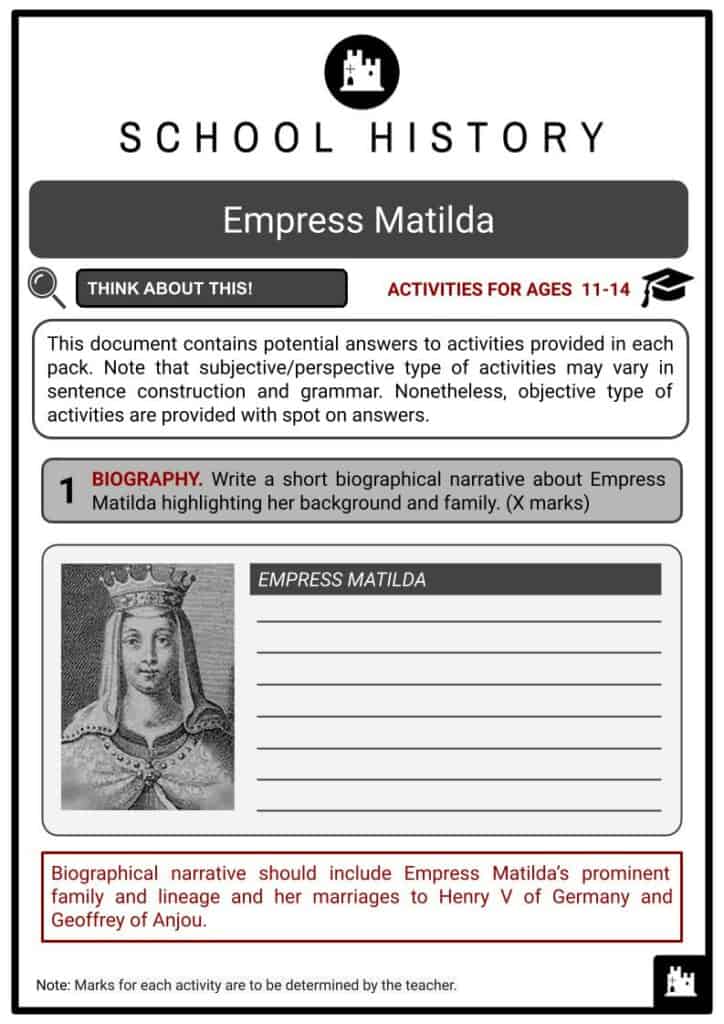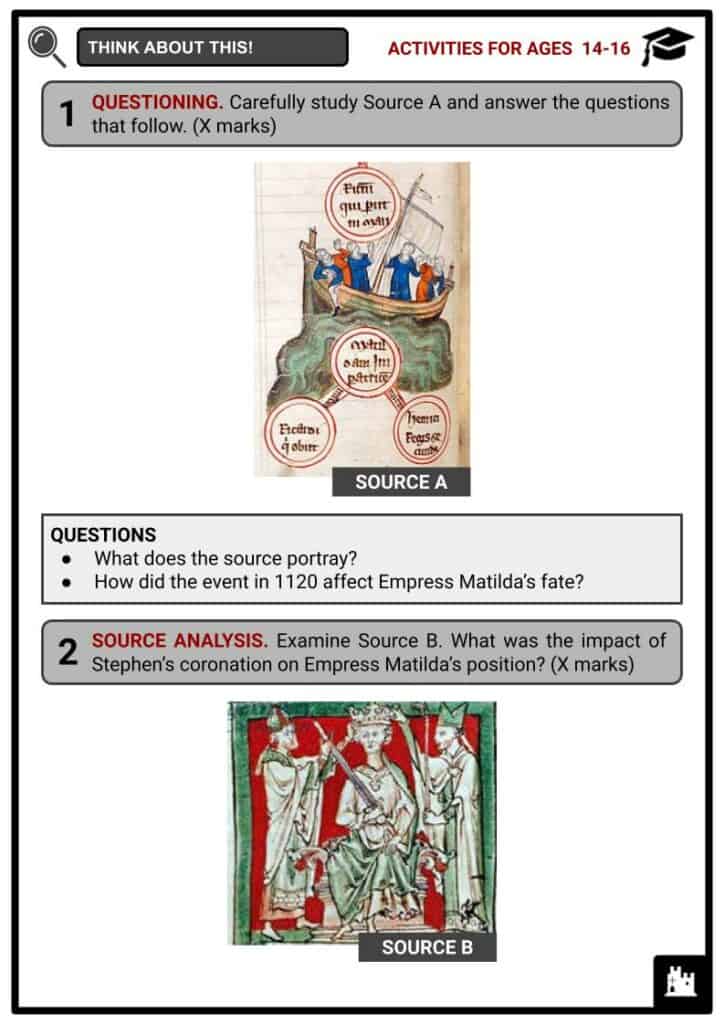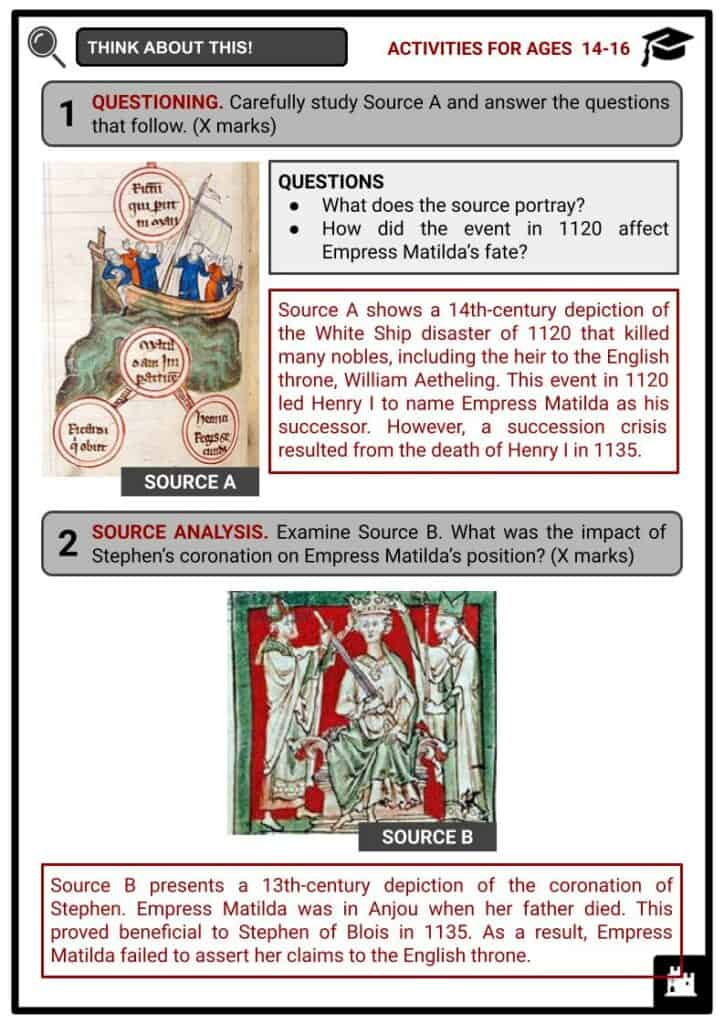Download Empress Matilda Worksheets
Do you want to save dozens of hours in time? Get your evenings and weekends back? Be able to teach about Empress Matilda to your students?
Our worksheet bundle includes a fact file and printable worksheets and student activities. Perfect for both the classroom and homeschooling!
Summary
- Background and first marriage
- Second marriage and the succession crisis
- Civil war
- Later years
Key Facts And Information
Let’s know more about Empress Matilda!
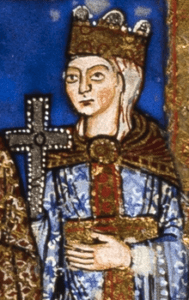
Daughter of Henry I, King of England and Duke of Normandy, and Matilda of Scotland, Empress Matilda was declared the successor to the English throne in 1126. Negotiated by her father, she was married twice: first to Henry V of Germany in 1114 and then to Geoffrey of Anjou in 1128. Upon the usurpation of the English throne by her cousin Stephen of Blois, she asserted her claims, resulting in the Anarchy that occurred from 1139 until 1153. Unable to decisively win against Stephen, she returned to Normandy in 1148 whilst her eldest son Henry continued the campaign in England. She concerned herself with the administration of the duchy until her death in 1167.
Background and first marriage
- Born in 1102 in Berkshire, Matilda was the daughter of Henry I, King of England and Duke of Normandy, and Matilda of Scotland. She had several illegitimate siblings by her father and only one younger, legitimate brother, William Aetheling.
- Matilda is thought to have received education in religious morals in her mother’s court.
- When Henry I travelled to Normandy in 1108, Matilda and her brother were left in the care of Anselm, Archbishop of Canterbury.
- Around 1108-09, Matilda’s marriage to Henry V of Germany was negotiated. Matilda was to be wed into one of the most important dynasties in Europe, and in exchange, Henry V would receive a dowry of 10,000 marks, which he needed to fund an expedition for his coronation as the Holy Roman Emperor.
- After the deal was finalised at Westminster, Matilda left England in early 1110 to make her way to Germany.
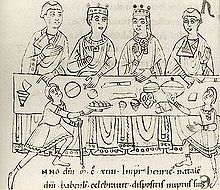
- The official betrothal took place in April in Utrecht, followed by Matilda’s coronation in July at Mainz. Matilda was only eight years old at the time while Henry V was 24.
- Matilda was then taught the German culture, manners and government.
- The union finally occurred in January 1114 at the city of Worms.
- Shortly after the marriage, political conflict erupted across the Empire, which was provoked by Henry V’s arrests of his chancellor and several other German princes.
- This was followed by rebellions, opposition from within the Church, and the formal excommunication of Henry V by Pope Paschal II.
- In early 1116, Matilda and Henry V went to Italy, advancing on Rome a year later to settle matters with the Pope.
- However, the Pope fled when the royal couple arrived with their army. As a result, the papal envoy Maurice Bourdin crowned the pair at St Peter’s Basilica in the Pope’s absence.
- Following this coronation, Matilda, now playing a full part in imperial government, claimed the title of the empress of the Holy Roman Empire.
- Whilst this coronation was not considered an imperial one, Empress Matilda maintained the title from then on and this eventually became widely accepted.
- When fresh rebellions broke out in Germany in 1118, Henry V appointed Empress Matilda as his regent in Italy.
- Empress Matilda’s husband continued to be occupied by finding a compromise with the Pope.
- The pair remained childless until Henry V’s death in May 1125 in Utrecht.
- In possession of the imperial insignia, the empress was left in the protection of their nephew Frederick, the heir to Henry V’s estates. Lothair of Supplinburg was appointed as the new king.
- Empress Matilda, now aged 23, was left with limited options following her husband’s death: she could become a nun or remarry.
- Whilst she received some offers of marriage from German princes, she decided to return to Normandy.
- After giving up her estates within the Holy Roman Empire and leaving with her personal collection of jewels, her own imperial regalia, two of Henry’s crowns, and the significant relic of the Hand of St James, she was not expected to return to Germany.
Second marriage and the succession crisis
-
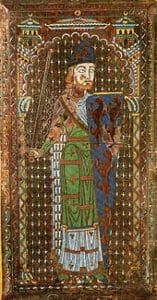
Geoffrey of Anjou, second husband of Empress Matilda Following the death of William Aetheling in the White Ship disaster in 1120, Henry I of England named his remaining legitimate child, Empress Matilda, as his successor. In 1126, Empress Matilda was in Normandy and had spent about a year at the royal court. At Christmas 1126, Henry I demanded his court take oaths to recognise Empress Matilda and her descendants as the rightful rulers, in order to strengthen the political support for his heir in England and Normandy.
- Henry I began to look for a new husband for the empress, in the hopes of improving his daughter’s position. He negotiated the marriage of the empress to Geoffrey, the eldest son of Count Fulk V of Anjou, in order to secure the southern borders of Normandy.
- Empress Matilda appeared to be disinterested in marrying Geoffrey, who was only 13 at the time.
- Persuaded to go along with the engagement, she travelled to Rouen in 1127 with his half-brother Robert of Gloucester.
- Henry I knighted Geoffrey, and in June 1128, Empress Matilda and Geoffrey were officially married.
- By 1129, Geoffrey was declared the Count of Anjou and Maine.
- Empress Matilda’s marriage appeared to be a difficult one.
- In fact, the empress left Normandy soon after the marriage and only reunited with her husband in 1131. The couple had three children: Henry, Geoffrey and William.
- Concerned about their lack of genuine support in England, Empress Matilda and Geoffrey suggested in 1135 that the king should grant the royal castles in Normandy to his successor, and should demand oaths of allegiance to Empress Matilda from the Norman nobility. However, Henry I rejected these suggestions.
- When Henry I unexpectedly died, Empress Matilda and Geoffrey were in Anjou supporting the rebels in their campaign against the royal army.
- Empress Matilda and Geoffrey grabbed the opportunity to march into southern Normandy and take over a number of key castles around Argentan.
- They were unable to advance further due to increased resistance from the Norman nobility and an uprising in Anjou itself.
- Meanwhile, Empress Matilda’s cousin, Stephen of Blois, who was in Boulogne, quickly left for England with his military household.
- Having gathered enough baronial support and secured the royal treasury, Stephen was crowned king of England on 22 December 1135.
- His younger brother, Henry of Blois, ensured the support of the Church to him, while his older brother, Theobald, who was thought to have the most valid claim over the kingdom, was forced to accept his succession.
- In early 1136, Geoffrey invaded Normandy and after a temporary truce, invaded again later that same year.
- Stephen then travelled to the duchy in 1137 and formed an informal alliance with Louis VI of France and Theobald against Geoffrey and Empress Matilda.
- However, Stephen was forced to give up this campaign and agreed to another truce with Geoffrey to maintain peace along the Norman borders.
Civil war
- Since 1135, Empress Matilda had not been particularly active in asserting her claims to the English throne. In essence, Robert of Gloucester was the one who initiated the declaration of war in 1138 by renouncing his fealty to Stephen and declaring his support for Empress Matilda. This triggered rebellion across the southwest of England, Geoffrey’s re-invasion of Normandy, and David of Scotland’s declaration of support for Empress Matilda and subsequent invasion of the north of England.
- By 1139, an invasion of England by Robert and Empress Matilda was forthcoming. Geoffrey, Empress Matilda and Robert had mobilised forces for a cross-Channel expedition at the beginning of the year.
- From that same year, England descended into civil war, known as ‘the Anarchy’.
- Empress Matilda and Robert arrived in England and established themselves in the southwest whilst Stephen’s power base lay in the east.
Timeline of the Anarchy
- Empress Matilda landed at Arundel Castle in 1139. Stephen besieged the castle, trapping his rival inside. Possibly persuaded by Henry of Blois to release the empress and to concentrate on attacking Robert, the king agreed to a truce.
- Rebellions also broke out in East Anglia led by Nigel, Bishop of Ely, and in the north, headed by Ranulf of Chester. Order was temporarily restored in the east. Ranulf escaped Lincoln Castle and proclaimed his support for Empress Matilda.
- At the Battle of Lincoln in 1141, the forces of Robert and Ranulf turned out to be superior to Stephen’s army. Stephen was captured and imprisoned for nearly nine months, during which he was poorly treated.
- Empress Matilda took this chance to establish herself as the queen of England. However, her arrogance was soon hated by her supporters and the English people whilst Stephen remained popular. The clergy declared the empress ‘Lady of England and Normandy’ as a precursor to her coronation. Advancing to London to stage her coronation, Empress Matilda faced an uprising by Stephen’s supporters and was forced to flee to Oxford, uncrowned.
- That same year, Robert was captured by Stephen’s wife, Matilda of Boulogne, with the aid of loyal nobles and Flemish mercenaries. Stephen was exchanged for Robert, weakening the position of Empress Matilda.
- A fresh coronation of Stephen and Matilda occurred at Christmas 1141. Stephen then besieged the castle in Oxford, where his rival was based. Empress Matilda fled to Abingdon Abbey and then Wallingford Castle.
- In 1143, Robert besieged Wilton Castle, where Stephen was staying. This led to the Battle of Wilton, in which Stephen was almost caught for a second time. With the fierce rear guard effort of Stephen’s steward, the king was able to escape from the battlefield.
- Stephen also faced threats in other parts of his domain. Geoffrey de Mandeville, Earl of Essex, rose up in rebellion against him in East Anglia in late 1143 until 1144. Ranulf revolted in the north in the summer of 1144. Robert and his followers continued to raid the surrounding royalist territories in the west.
- Meanwhile, in 1144, Geoffrey was able to secure his hold on southern Normandy, advancing into Rouen and concluding his campaign. Louis VII of France recognised him as Duke of Normandy. Whilst victory appeared to move slightly in Empress Matilda’s favour, she failed to consolidate her position.
- The death of Robert in 1147 and of several of the empress’ key supporters wore out Empress Matilda’s forces. She retired to Normandy afterwards and her eldest son Henry took up the mantle of claiming the English throne.
- In the late 1140s, Henry attempted to invade England twice but failed. He was increasingly gaining a reputation as a capable leader. Meanwhile, Stephen started to focus on the issue of his family and the succession. Henry’s victory in England came in 1153, in which he managed to take control of much of the country with little fighting. Stephen and Henry began peace negotiations soon after, bringing an end to the Anarchy.
Later years
-
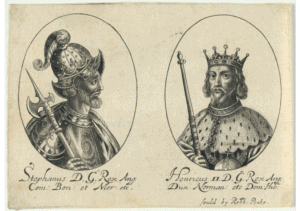
Depiction of Stephen and Henry II From 1148, Empress Matilda became increasingly devoted to rebuilding her court in Rouen, the Church affairs and her personal faith, rather than the war in England. Nevertheless, she remained supportive of her son’s expedition to England. Geoffrey died in 1151.
- Empress Matilda faced considerable disorder and the threat of baronial revolt in Normandy.
- When her eldest son assumed the English throne as Henry II on Stephen’s death in 1154, the troubles in the duchy died away.
- Henry II was the first king of the House of Plantagenet.
- For the remainder of her life, Empress Matilda stayed in Normandy, presiding over the administration of the duchy in Henry II’s absence.
- Her influence on Henry II’s decisions and policies were significant.
- Empress Matilda also helped settle several diplomatic crises:
- Empress Matilda persuaded the Holy Roman Emperor Frederick I to receive an alternative set of luxurious gifts in place of the valuable relic of the Hand of St James that the empress brought with her to Normandy from Germany.
- Empress Matilda’s assistance was sought by Louis VII during a growing diplomatic row over the handling of Crusading funds.
- When Empress Matilda died in 1167 in Rouen, her remaining wealth was given to the Church.
- She was buried under the high altar at the abbey of Bec-Hellouin.
Image Sources
- https://upload.wikimedia.org/wikipedia/commons/thumb/b/b4/Empress_Matilda.png/220px-Empress_Matilda.png
- https://upload.wikimedia.org/wikipedia/commons/thumb/e/e8/Matilda_jidnrichInem.jpg/220px-Matilda_jidnrichInem.jpg
- https://upload.wikimedia.org/wikipedia/commons/thumb/1/12/Geoffrey_of_Anjou_Monument.jpg/170px-Geoffrey_of_Anjou_Monument.jpg
- https://www.npg.org.uk/collections/search/portrait/mw117955/King-Stephen-King-Henry-II-fictitious-portraits

